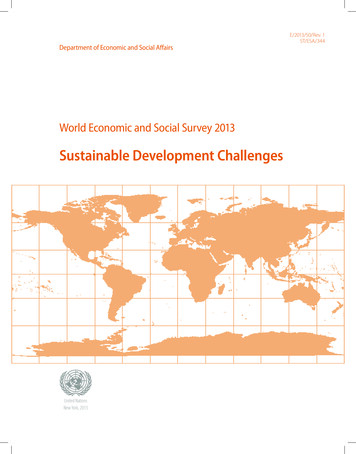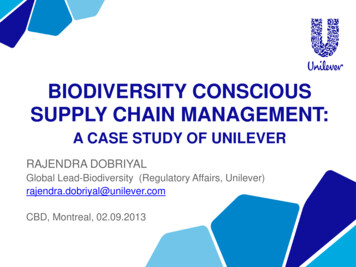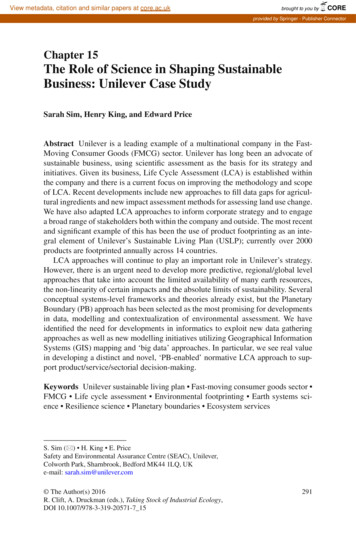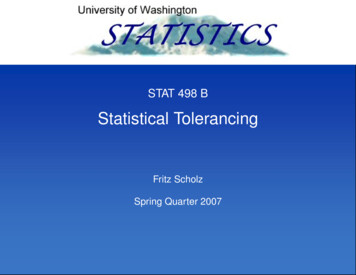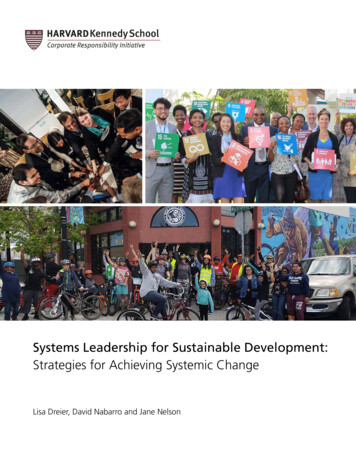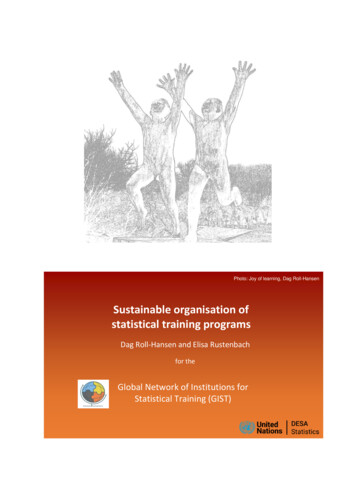
Transcription
Photo: Joy of learning, Dag Roll-HansenSustainable organisation ofstatistical training programsDag Roll-Hansen and Elisa Rustenbachfor theGlobal Network of Institutions forStatistical Training (GIST)
ContentsExecutive summary4a.Organising training in National Statistics Offices (NSOs)4b.Providing training4c.Sustainable courses5Way forward6Introduction7Background and methodological approach81.Why build a training programme?92.Developing sustainable courses3.4.10Supply and demand; fit the training into an NSO strategy10Enhancing learning outcome through training of trainers12Adapting material to a national context15Training modalities; face-to-face or e-learning15Training modalities; self-paced or facilitated, recording lectures, multi-platform delivery orblended learning16Soft skills and training for new employees17Language18Building sustainable training programmes19Building a whole19Training material as a common good21Learning paths24Training at different levels27Funding and other resources for training28Organisational setup and tasks29Extending training programmes to the National Statistical System (NSS)30Enhancing motivation to train and be trained31What excites you to train and learn?31Willingness to share knowledge31Visibility and recognition32Economic incentives33Training as a career path34Certificates and accreditation352
Time for training and learning355. Encouraging diversity in training376.Selecting participants using a framework37Gender balance37Ethnic and social diversity38Pre-training assessment38Supply of training39Identifying needs39Recommendations42Piecing together the puzzle42Establishing and further developing a standard set of courses for NSOs42Enhanced cooperation on development of courses42Identifying gaps filling them though e-learning42Training material on soft skills and dedicated training for new staff43Sharing training and training material43ANNEX 1: Considerations for Standardizing a Training Curriculum for NSOs44Essential hard/statistical skills that should be included in the set of courses for every NSO44Essential soft skills that should be included in the set of courses for every NSO45Training courses by career stage46Helping ensure NSOs identify their needs and international organizations collaborate in meetingsuch needs47Summing up49Glossary503
Executive summaryAs outlined in the full report following this executive summary, a national training programme shouldenable staff to produce statistics for evidence-informed decision making and inform public debate atthe national level, as well as reporting progress on the Sustainable Development Goals (SDGs) andother international and regional initiatives.The quality of statistics to a large degree depends on the abilities of the employees. Training canimprove the performance and productivity of the staff and ensure they have the relevant skills toproduce statistics in line with the United Nations Fundamental Principles of National OfficialStatistics. This report discusses and recommends ways to establish sustainable training in statistics,building on the work of the Global Network of Institutions for Statistical Training (GIST) and an initialassessment based on interviews with a number of countries that have different approaches tostatistical training at national level. The report is funded by the UN Statistics Division.Key proposals include:a. Organising training in National Statistics Offices (NSOs)The NSO management ought to be part of the training process. Without management ownership, it isnot likely to succeed. The management also has an understanding of both the existing competence inthe organisation and of what the needs of tomorrow will be.Lack of funding is a challenge for training and capacity development. It not only makes NSO unable topay for training, but also puts strain on staff making it difficult to find time for training others andlearning, as well as paying for local costs associated with receiving training from regional trainingcentres and international organisations.A training programme or centre is a crosscutting task and may be best administered under theDepartment of Human Resources in an NSO. The course organisation consists of several elements.Trainers must be identified, as well as training facilities and course participants. It is important tofind a way to motivate the trainers, find out when in the work-cycle to do the training and how tomake sure that new skills can be used immediately.Training needs can be identified, prioritized and a plan made to supply what is needed. This can formthe basis for learning pathways, guiding the professional development of the individual NSO staffmember. Training ought to be given when staff have the time to train and learn, preferably justbefore new skills can be used.Exchange of ideas and experiences between NSOs is also valuable to start using e-learning to buildcapacity in a cost-efficient manner.b. Providing trainingNew technologies have facilitated exchange of training material and communication across bordersand continents. This opens new perspectives on how training can be conducted. Not all courses needto be developed locally and conducted in a classroom. Even though face to face training has manyadvantages, we should further strengthen initiatives aiming to share training material and enhancedistance learning. Internet-based training courses could be an integrated part of the trainingprogramme. This may give a significant increase in access to training. Some NSOs report that a turnto virtual training caused by the pandemic has helped them fill the need for training as the cost ofvirtual training is generally lower than the cost of classroom training.Coordination among providers of training to NSOs is needed to give them access to a comprehensiveset of training they can use to fill their gaps in line with national priorities. A coordinating body couldlook at the demand of statistics offices and negotiate a division of tasks between them on whoshould be responsible for different parts of the statistical production. This division of responsibility at4
the global level could be reflected in development of training material and technical assistance to thecountry level. Lack of coordination makes it difficult for NSOs that rely heavily on training fromoutside to get all the courses they need.A recommended standard set of courses for NSOs could be established, taking into account the needto have training for staff at different levels, including both level of expertise and length ofemployment. Soft skills should be included as a natural part of the NSO standard courses. Thestandard courses ought to be periodically reviewed and updated.When training is given as part of a development project it is often not based on the needs andpriorities of the NSO. As an example, many projects come with training in field work, regardless ofwhether this is a need in the NSO or not. Trainings given as part of projects must be aligned with thetraining program of the NSO.The focus of regional and international organisations has so far been to supply training, they do notusually help countries organise training programmes. In the future, NSOs and NSSs may also benefitfrom more hands-on cooperation on how to organise locally relevant training programmes andbuilding national capacity to train.Regional training institutes and international organisations have their specific mandates, and henceprovide support and courses within specific areas. Even though a few of them offer training in softskills, this is not their primary focus. Hence, from the NSO perspective, the offering of training in softskills is limited. The same is the case for training for new staff. Even though such training will oftenneed a degree of adaptation to each NSO, there are still generic elements to it that can be developedby regional and international organisations.c. Sustainable coursesAdults often want training that is directly relevant for the task they are going to solve. Hence,training aimed at solving a task or a problem motivates participants and will often be put to use afterthe training has ended. Focusing on internal motivators will make it easier to recruit learners thatparticipate in order to learn rather than external motivators like money. Training could lead tosomething, like visibility, interesting tasks, accreditation or be part of a career path. At least trainingshould be more than a diploma on the wall.Motivation and opportunity to take part in training will influence the composition of participants.Selecting participants to attend training ought to be based on their training history, position andduties at the NSO. It is often considered an advantage to ensure equal opportunity to participate intraining for both women and men.Trainers need to be empowered in their role as trainers. The role can give visibility and allows themto cooperate with and learn from colleagues. By being involved in training you may increase yourown network and promote yourself internally. An important qualification of a trainer is to inspire joyof learning among students.In many organisations there is belief that giving away knowledge may weaken your position or makeyou redundant. If staff members have seen colleagues weaken their position as a result of sharingknowledge, they are less inclined to do so themselves. To change this, staff must be convinced thatsharing knowledge is more likely to strengthen than to weaken their position in the organisation.Work in an NSO requires a combination of practical and theoretical skills sometimes cannot be foundat universities. Many NSOs are requesting material that can give them practical solutions related tothe production of statistics. Structuring trainings in a pedagogically sound way, enhances the benefitlearners have from the training. Presentation techniques can be used to mediate the content tocourse participants in a way that helps them learn. Having one or two assistant trainers increases thepossibility someone will be able to teach the course, even if the original trainer is no longer available.5
Training of trainers can contribute to building sustainable capacity among internal NSO trainers,enabling NSOs to repeat courses as needed to fill prioritised gaps.All courses could be evaluated with an aim to improve them. To learn to improve pedagogicalpractises, it may also be helpful for trainers to receive positive feedback, to learn what trainingmethods learners appreciate. This can help trainers know what techniques works, not only what doesnot work. Evaluation of the impact training has on work is important, as training only has value if itimproves work.Skills have to be used to be developed. If an NSO wants to train staff in e.g. R, this is a continuouslearning process. The ones knowing it can be used to train other colleagues in the NSO. Champions orsuper-users can train others and learning teams can be established to enhance professionaldevelopment.Way forwardOrganising training programmes is a national responsibility, but valuable support to NSOs and NSSs isgiven by regional training institutes and international organisations. A key challenge is to structurethe cooperation to ensure that the national needs for training to produce official statistics isaccommodated, and that NSOs and NSSs are positioned to define their needs, setting NSOs in thedriving seat of the training agenda.6
IntroductionA national training programme ought to build capacity to produce statistics in a wide range of areas.It should aim to enable staff to make statistics to fill the needs of evidence-informed decision makingwithin national governments and inform public debate. Further, it should aim to build skills neededto report progress on the Sustainable Development Goals (SDGs) as well as other international andregional initiatives, adhering to the United Nations Fundamental Principles of Official Statistics.The quality of statistics produced by a National Statistics Office (NSO) to a large degree depends onthe abilities of the employees. Hence, making sure the staff has adequate skills is crucial. Training canimprove the performance and productivity of the staff and ensure they have the relevant skills.The management must be part of the training process. Without management ownership of training,developing sufficient capacity may be challenging. The management also has an understanding ofboth the existing competence in the organisation and of what the needs of tomorrow will be. Aprincipal task of the management is to bring out the best in people: Find out what an employee doesthe best and make him or her do it even better.This report discusses social and organisational structures influencing training programmes andrecommends ways to establish sustainable training in statistics. It looks into development of coursesthat can be repeated with minimal effort and combined in a training programme. Further, noneconomic incentives to motivate students and instructors are discussed, as well as recruitingparticipants that benefit most from the training regardless of gender, age and status in theorganisation.The report was commissioned by the Global Network of Institutions for Statistical Training (GIST) andis a follow up to the report Sustainable Statistical Training Programs at NSOs1, and builds oninterviews with a selected number of countries as well as two remote workshops withrepresentatives from international agencies, regional training institutes, NSOs and other partners.The report is funded by the UN Department of Economic and Social Affairs, Statistics Division (UNSD)who also acts as a secretariat for SOs.pdf7
Background and methodological approachDuring the months of December 2020 and January 2021 consultants for the Global Network ofInstitutes for Statistical Training (GIST) conducted interviews with 15 countries and 7 regional trainingcenters with the objective of investigating how training is organized at NSOs and how they aresupported by regional training centers2. The report resulting from these interviews highlighted fourrecommendations:1. Establishment of a repository of training materials and tools that can be used as a globalcommon good on an international multilingual platform.2. A standard set of courses to give NSOs a starting point to identify training needs and developa training programme.3. Development of international recommendations for establishing or growing a sustainabletraining program in NSOs.4. Strengthening and clarification of the role of regional and international organization inbuilding country level training programs.As a follow up to these recommendations, two workshops were held in February 2021 focused onthe second and third recommendation. The workshops included approximately 25 participants eachfrom NSOs, regional training centers and international organizations. Participants were broken intofive discussion groups and each group had an hour to discuss the below questions.Workshop on standard set of courses for NSOs:1. What topics should a standard set of courses at every NSO include?2. What soft skills courses are essential to an NSO training set of courses?3. What courses would you consider essential for employees to take on the first year on thejob?4. How can NSOs identify clear training needs and how can international organizations meetkey needs?Workshop on organisation of training programmes:5. What steps can be taken to ensure every course is developed in a way that is sustainable can be retaught with minimal effort?6. How can a few individual courses be built into a full set of courses over time?7. What are non-economic incentives to motivate students and instructors?8. How to ensure the right people attend courses - gender balance, younger staff representedand courses are applicable to required skills?The purpose of this report is to provide recommendations for a standard set of courses as well asorganisation of training programmes at NSOs resulting from the workshop discussions. The outcomeof the workshops was supplemented by interviews with NSOs to gain additional insight in ograms-atNSOs.pdf8
1. Why build a training programme?Having the necessary competence is crucial to any NSO. It can be built through various kinds oftraining. The need for training can be identified based on existing competence within the NSO. Towork in a NSO you need a combination of practical and theoretical skills that most often cannot belearned through formal education. Training staff to have the right skills hence often is a challenge.This is why NSOs often establish training programmes to give their staff the training needed.Effective training may be particularly important when hiring new employees or when the tasks or thetechnology at hand are changing.An internal training programme is often a cost-effective way of organising training. There are severalreasons for this:1.2.3.4.training can be scheduled at your conveniencetraining is more focused, consistent and relevant to your needstravelling and accommodation costs can be reducedknowledge can be passed down within the organizationTraining courses may be designed and carried out by the NSO’s own employees, national experts orforeign experts. Internet-based training courses should be an integrated part of the trainingprogramme, as it can provide a rich variety of courses and is often cost -effective.The need must be identified based on existing competence in the NSO. An important aspect inbuilding the right competence is to find out what the different employees are good at and like doingthat is important for the NSO. Then they should do more of this and learn it even better.The difference between what competence you have and what you need is what you ought to focuson achieving. To find out what is needed, a needs assessment or gap analysis may be conducted.The course organisation consists of several elements. Trainers must be identified, as well as trainingfacilities and last but not least: the course participants. It is important to find a way to motivate thetrainers, find out when in the work-cycle to do the training and how to make sure that new skills canbe used immediately.The gain of successful training can be found on two levels, both on the personal and theorganisational. For the individual more competence may give increased responsibility, moreinteresting work, higher salary and a future career. The organisation will be less vulnerable, haveincreased efficiency and higher productivity. When the staff has the right skills, it will be easier to getthe job done with sufficient quality.A training programme or centre is a crosscutting task and may be best administered under theDepartment of Human Resources. The directors of the different departments may give input on whatcourses they need. The management should prioritise the suggestions for building competenceaccording to plans and budget limitations.NSOs working to strengthen training and develop capacity relate to a complex reality, making thetask multifaceted. Each NSO has its own strengths and weaknesses, but many struggle with financialconstraints, hierarchical or inefficient organisations, lack of motivated staff, lack of prior skills amonglearners and lack of potential trainers. This report is based on workshop discussions withrepresentatives from international organisations, regional training centres and NSOs, in addition tointerviews with NSOs and regional training centres. The aim of the report is to shed light on some ofthe issues raised and suggest some considerations moving forward.9
2. Developing sustainable coursesAn NSO can start with few individual courses before developing a complete set of curricula. This willlead them to a better way to find a more robust syllabus after having feedback from variousparticipants. As an example, newly recruited staff can be trained in basic ideas of official statistics,data analysis, data presentation and dissemination techniques. Improved feedback from participants,a comprehensive syllabus for the official training courses can be developed which will be offered tothe future generation. This is a way forward suggested by the Central Bureau of Statistics (CBS) ofNepal.Supply and demand; fit the training into an NSO strategyNSOs both produce their own training and receive training from regional and internationalorganisations as well as bilateral donors that often have their own priorities or specific objectives. Itis key to integrate training supplied by external providers into the training programmes of the NSO ina way that helps fill their training needs. Sometimes it is a challenge to match the training given bydonors with what is needed by the NSO, both because donors pursue their priorities and becausesome training is in short supply. This may be particularly challenging when training is given as part ofa project, not based on the needs of the NSO. As an example, many projects come with training infield work, regardless of whether this is a need in the NSO or not.Pieces of training done by consultants are often tied to surveys. There is low technology, onetraining is given for each survey, and they are not seen in relation to each other. The trainingis not reusable at the NSO and generally only used once there. The immediate need (i.e.survey) defines what training is given, not the long-term needs of the NSO. The institutionalneed for creating a training body is key.Rajiv Ranjan, Technical Programme Advisor, PARIS21NSO training needs should define the training agenda, rather than individual projects. A step on theway could be to use training material from the NSO, integrating project specific elements, whenconducting a standardised survey.Regional and international organisations use different ways to identify NSO needs. Some send outquestionnaires with regular intervals asking NSOs to report what their needs are. Other organizationsoffer their services by presenting a Terms of Reference (ToR) for the training or asking the NSO todraft one. Others use workshops to align their training offerings to the needs of the NSOs:We suggest curricula to answer country demands, validate it with workshops. We alsopresent the curriculum to other countries with similar demands.Mamadou Cisse, Training Officer,African Institute for Economic Development and Planning (IDEP)Some NSO needs are quite specific, creating a need to align the learning objectives with needs ingreat detail. In other cases, the training offered is more general, with less need for interactionbetween the NSO and the training provider to specify training needs. The collaboration betweenregional and international organisations and NSO also depends if the NSO has a dedicated trainingunit or not. Training units in NSOs generally have a role in aligning expectations and organising10
courses. The High Commission for Planning, the NSO of Morocco, tries to select new topics, that theycan later give in-house when offered training from international partners.Organisations that have been operating for a number of years, generally have a substantial amountof training material available. Regional and international organisations have a wide array of coursesdeveloped, that can be retaught, after being updated and adapted to context if need be. Whenever atraining is provided by an international organisation or a consultant, one or preferably two nationalstaff members could act as assistant trainers, building capacity to conduct the training at a laterstage. Material made available to the global community could further benefit other organisationsthan the ones developing the material.Many NSOs do not use their own staff to train colleagues. There are multiple reasons for this, e.g.lack of knowledge, lack of time to teach, lack of incentives to train others or disincentives to shareknowledge. These explanations why training is not happening are relevant to some degree in mostNSOs, and often exist in combination, making sustainable training challenging. Nevertheless, someNSOs are actively working to solve these challenges, promoting a culture of training and learning.Both the Central Statistics Agency of Ethiopia (CSA) and the State Statistics Service of Ukraine (SSSU)are working to enhance training by internal trainers, e.g. by training them in structuring andpresenting learning material. The aim is to strengthen their own supply of trainers in statistics. SSSUalso has an Academy of Statistics, which provides training for SSSU, including its territorial bodies andalso gives training to other countries, like Azerbaijan and Morocco.We need more sustainable training conducted by ourselves, but in the beginning it will bevery difficult to do everything ourselves. So, at the starting point we need the experiencedorganisations to help us establish the system, develop curriculum, to work with us until weare well capacitated, then CSA can take it over.Aberash Tariku, Deputy Director General, CSA EthiopiaUniversities and other academic institutions also take part in developing training in statistics. Anexample of this is the European Master in Official Statistics (EMOS), a joint project of universities anddata producers in Europe providing post-graduate education in the area of official statistics at theEuropean level. Another example is the Palestinian Central Bureau of Statistics and the MalawiNational Statistics Office both working with universities to have relevant training for their staff. Iflocal statistical institutions exist, developing partnership on training can be fruitful to make betteruse of scarce resources.Some NSOs have weak technological infrastructure, and training provided ought to be adapted tomeet these limitations. This is particularly relevant for e-learning and other electronically supportedlearning like e.g. streaming of videos where limited bandwidth may be a challenge. To make itpossible to utilize material already developed in low-resource settings, technological limitationsshould be considered. The Grenada Central Statistical Office reports that an array of virtual coursesare available, but that lack of internet access limits staff access to them.Timing of training should be given some consideration. In Nepal, CBS has recently revised theirnational account series and planned for training on national accounts before the revision.Unfortunately, staff did not get the training until after the revision was done, and were not able tobenefit from and practice what they learned during the revision.Some NSOs have assessed their needs, and have specified what topics they need training on, askingdonors to provide specific courses. This can e.g. be the case if an NSO has developed a list of coursesthey are asking donors to contribute to. Donors often have priority areas to support which does notnecessarily match the needs of an NSO.11
Even though priorities of NSOs are generally anchored in national strategies and development plans,the priorities may change as a result of changes in the NSO management or the national government.In Myanmar, partners perceive there is a risk in investing in areas that are not clearly specified in theNSDS, even before the unrest initiated in February 2021.The focus of regional and international organisations has so far been to supply training, they do notusually help countries organise training programmes. In the future, NSOs and NSSs may also benefitfrom more hands-on cooperation on how to organise locally relevant training programmes andbuilding national capacity to train. Regional cooperation on statistical capacity building may also helpadapt training to fit the needs of NSOs and NSSes in a region.Regional cooperation on statistical capacity building in the CaribbeanThe Standing Committee of Caribbean Statisticians (SCCS) constituting the premier forum forstatisticians in the small islands and low-lying states of the Caribbean Community (CARICOM) startedcooperating to build statistical capacity in the late 1970-ies, and based on an assessment of trainingneeds, of countries, made recommendations to establish the Caribbean Institute for StatisticalTraining and Research (CISTAR). CISTAR aimed to meet the statistical needs at all levels and to alsoundertake applied statistical research to develop statistical measures, focusing on improving theproduction, dissemination and analysis of statistics. Recently, the SCCS has proposed theestablishment of e-CISTAR, and an electronic platform for Statistical Training and Research in theCaribbean has been developed as a foundation to provide access to training and to enhance theavailability of statistical resources to the statistical systems of the Caribbean.Organising training programmes is a national responsibility, but valuable support to NSOs and NSSs isgiven by regional training institutes and international organisations. A key challenge is to structurethe cooperation to ensure that the national needs for training to produce official statistics isaccommodated, and that NSOs and NSSs are positioned to define their needs, setting NSOs in thedriving seat of the training agenda.Training sometimes leads to disagreements. There can be inconsistencies between the supply oftraining from international organisations and regional training centres and the demand from NSOs.Disagreements can also be triggered by competition for access to training at the NSO level. In bothcases conflicts can be caused due to limited access to training, and may partially be solved by asignificant increase in access to training.NSOs often face similar challenges in establishing training programmes. The Philippine StatisticalResearch and Training Institute (PSRTI) advises countries in the process of est
Training material on soft skills and dedicated training for new staff 43 Sharing training and training material 43 ANNEX 1: Considerations for Standardizing a Training Curriculum for NSOs 44 Essential hard/statistical skills that

